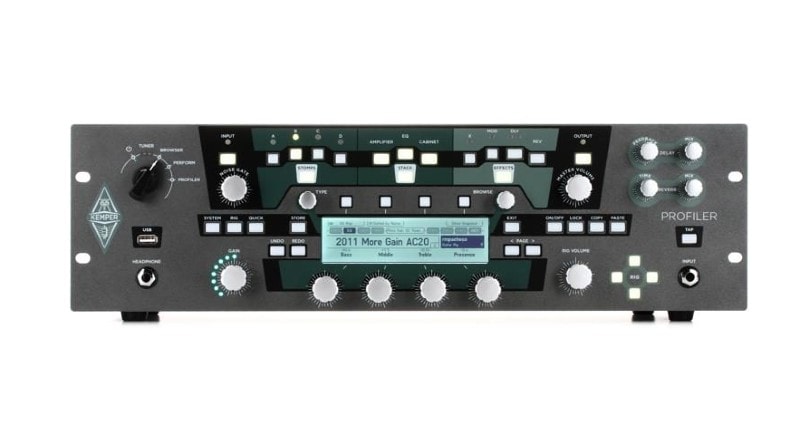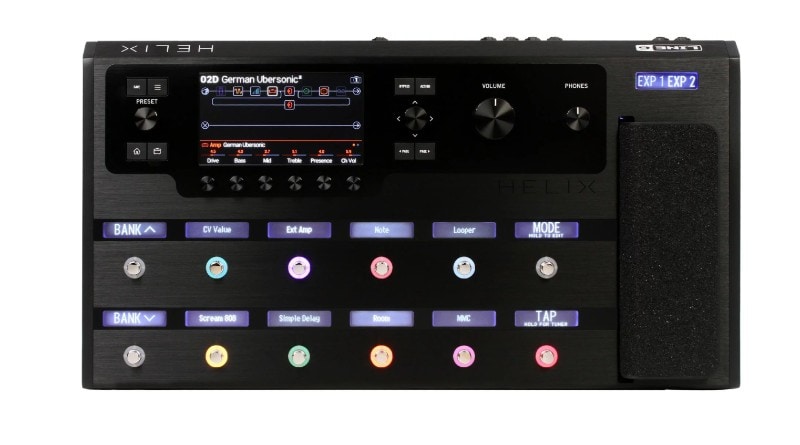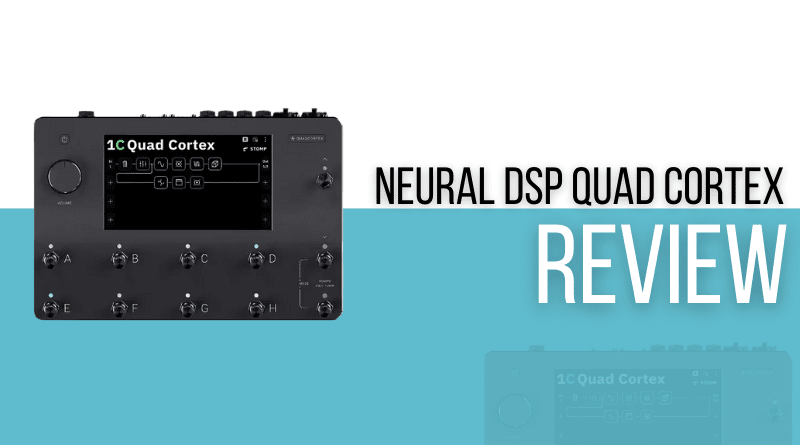Amp modeling has advanced leaps and bounds in recent years, and one of the pioneers of this next generation of gear has been Neural DSP. While they don’t have the mass market brand presence of Boss or Line 6, they have become something of a major player in the world of FX and modeling thanks to their revolutionary Quad Cortex.
The Quad Cortex is the first hardware item from Neural DSP, who are mostly known for their plugins, and it has made quite a splash since its introduction. At its core, it’s modeled around the same plugins that put this brand on the map, but does this stomp-box-style FX and modeling unit live up to the reputation it’s built? Keep reading to see what we found.
Read more about our review process.
Contents
Neural DSP Quad Cortex: Who Is This For?
The Neural DSP Quad Cortex is aimed primarily at intermediate players, but the incredible sound quality and huge array of features makes it a great choice for advanced guitarists and working musicians, too. The price point may seem high at first, but with Sweetwater’s financing options you can usually pick up a Quad Cortex for somewhere around $50 a month, putting it within reach of most players.
Neural DSP Quad Cortex: Appearance / Features / Controls
The Quad Cortex is a great-looking unit. It’s built within an anodized aluminum housing and we particularly liked the matte black finish. As we mentioned earlier, this is Neural DSP’s first attempt at hardware, so (for now) there is no rack-mounted version. It’s available as a stomp box only.
The centerpiece of the exterior is the 7-inch LED touchscreen. Without giving too much away, we found it to be bright and thanks to the semi satin finish, it was easy to read in all lighting conditions, including under harsh stage lighting. The touchscreen is clearly the way that Neural DSP intended users to interact with the unit. The touch response was excellent and very similar to that of an iPhone – accurate and responsive.
All of the Quad Cortex’s features can be accessed by the LED screen or by programming the presets to the 8 available stomp buttons. You can easily cycle through menus using the multifunction mode/tempo/tuner stomp buttons, too. Over on the left, there’s a large volume/power knob.
On the back of the unit, you’ll find all of the available inputs and outputs. Starting from left to right, you’ve got the two combo inputs, which can accommodate standard ¼” jacks as well as XLR, TS, and TRS. These inputs are equipped with preamps and phantom power supplies in case you’re planning to run a microphone through the QC.
Next, the dual send and return loops. Not only do these loops allow you to embed mono and stereo effects through the signal chain, they also act as additional input and output jacks.
One row over, the Quad Cortex gives you a further 2 mono outputs. These outputs are balanced and offer incredible sound quality. It features a headphone-out and 2 XLR outputs.
There is a MIDI in and a MIDI thru/out control to allow for sending and reception of MIDI signals. Ultimately this MIDI control allows you to automate the entire range of functions of this pedal. Additionally, there are a pair of expression pedal inputs, which can be rigged to allow you to control wah, pitch changes, or volume using a pedal.
Next, you’ll find the USB port, which is of course used for firmware updates, audio transfer, and even MIDI control. On the extreme right, you have a 12v DC power input.
The fit and finish of everything on this pedal is absolutely incredible. The stomp switches offer rotary control as well as click-in click-out, and are made out of stainless steel. Neural even goes so far as to call them unbreakable.
Neural DSP Quad Cortex: Performance/Sound
We’ve been waiting to get our hands on this ever since it was announced at winter NAMM 2020. This is one of the most anticipated gear releases in recent memory, so we were truly hoping it would live up to the hype.
One of the things we noted first was just how compact this unit is considering what it’s capable of. One of the things that helped Neural DSP to make the Quad Cortex so compact was the combination stomp button rotary dials. This kept the deck of the unit clear, which makes the playing experience so much better. The rotary motion is used to control the parameters within the settings you activate from the touchscreen, and the hardware and software interact beautifully.
The homepage gives a very nice visual of the signal flow you have set up within your system in a sort of digital representation of a daisy chain of pedals on a board, showing the linear flow from guitar to amplifier.
After we spent some time exploring the vast number of modes and pages, we decided it was time to check out the amplifier model presets. We found that the presets were good, but certainly benefited from some of the extra EQ found onboard. Tonal possibilities are practically limitless if you understand what you’re doing with compression and EQ, though.
One thing we did note was a slight hiss when amp profiles were played with low gain. This went for both the presets and the Stage Right Profile we made. With the gain turned up, the hiss is pretty much eliminated, but you’d probably want to introduce a noise gate if you were planning to record anything clean.
One of our favorite features was the ability to play with the cab settings. Not only are you able to modify the amp parameters, you can even adjust the position of the virtual microphone to wherever you’d place it by the speaker on a physical cab. This is an incredible advancement and brings game-changing dynamics to this unit, especially for those planning to record with it.
Another incredible feature of this pedal is the ability to capture the profiles of amps, heads, or even entire rigs using the Neural Capture functionality. If you’ve used a Kemper before, the process will be quite familiar. But in the case of the QC, we were blown away by how quick and easy it was. Once we’d selected Neural Capture, we were presented with a full visual setup guide to walk us through the process of connecting the amp we wanted to model. In this case, our little 5w Stage Right tube amp. The process took quite a while, but the results were outstanding, with absolutely no discernible difference between the live amp and the modeled version in the Quad Cortex.
Of course, we had to spend some time with the preset FX built into the unit, too. While not disappointing, they weren’t the strongest element of the Quad Cortex. There were models based on many of the most popular pedals on the market (think Klon, Tube Screamer, etc.), but as presets, they didn’t quite match what you’d expect from an equivalent standalone stomp box. We adjusted the parameters on some of the effects and did manage to get some really great tones in the end.
If you aren’t having any luck adjusting any of the preset FX to your liking and you already own, or can borrow, a particular pedal you’re looking to emulate, you can always use the Neural Capture to model it, too.
Other Amp Modeler/FX Units to Consider
The Neural DSP Quad Cortex is one of the newest units of its kind on the market. There are still, of course, alternatives to consider if the QC isn’t quite what you’re looking for:
Kemper Profiler

Kemper’s Profiler Amp Head is one of the originals (along with the Axe FX), and still is one of the best when it comes to amp profiling. It’s renowned for its incredible sound quality, huge variety of presets, and seemingly endless parameter modification abilities.
It is available in both rack-mounted form and as a floor-based stomp box. Both the rack and floor-mounted versions are much less portable than the Quad Cortex, but on the plus side, they feature better sounding preset FX out of the box.
Check out our full Kemper vs Quad Cortex head to head here.
Line 6 Helix

Line 6 is one of the big names when it comes to digital effects processing, so you shouldn’t be surprised to see them in the company of giants like the Kemper and Quad Cortex. There are multiple versions of the Line 6 Helix available and, like the Kemper, you can buy it in rack- or floor-mounted configurations.
Helix models have a lot of aftermarket support available in terms of downloadable, premade amp, and FX models, although they really excel when it comes to modeling and modifying new FX and amps.
Check out our full Helix vs Quad Cortex head to head here.
Final Thoughts on the Neural DSP Quad Cortex
We had a lot of fun experimenting with the Neural DSP Quad Cortex. There are so many thousands of available settings that it would take months to explore them all. As an amp and pedal modeler, the Quad Cortex is incredibly impressive. It can mimic anything you throw at it in a very convincing way. And while the presets aren’t the most exciting, you don’t buy a Quad Cortex for preset FX and amps alone.
Something worth noting, however, is that the Quad Cortex operating system is still in its infancy. Updates will come in the future and if we know anything about Neural DSP, it’s that they are always improving upon their existing products. Things like the hiss we heard on clean tones will almost certainly be fixed in future releases and we have no doubt that we will see improvements with the preset amps and FX, too.
Check out these other articles about amps:


